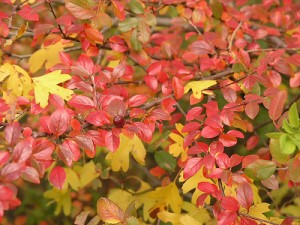Fall is a great time to do some color planning for your garden. You can look at other people’s yards and see ideas for plants that are blooming and changing foliage color at this time. If you decide that you want to add some new trees and shrubs for fall interest next year, many can be planted successfully at this time; in fact, for many, this is the ideal time instead of spring. This is also the time to start considering what spring flowering bulbs you will want to plant soon, which we will cover in a subsequent post.
Three Types of Trees That Provide Fall Colors
Maples are likely the first trees that come to mind when we think of autumn foliage. The palm shaped leaves come in a wide assortment of shades like red, orange, yellow, purple and brown. Depending on the species you choose (some produce better than others), you can also tap them in late winter to make maple syrup.
Oak trees also put on a good show with their leaves in hues of red, yellow, brown and orange. The acorns can also be used to make fall decorations for your house.
Aspen trees have foliage that turns yellow in autumn. Since these are often found in higher elevations where evergreens live, the pop of color is especially lovely. This can work for your garden too as a focal point.
Three Types of Shrubs That Provide Fall Colors
Cotoneasters are sturdy shrubs that will brighten up your landscape with their scarlet foliage and fruit. Two to look for are the rockspray cotoneaster and the willowleaf cotoneaster.
An underused shrub is the redvein enkianthus, which provides several seasons of color. In the spring it produces gorgeous clusters of white flowers with pink veins. In fall, the foliage becomes orange, red or yellow.
Serviceberries have white flowers that turn into edible fruits. In autumn, the leaves will turn to orange and red.
What are your favorite ways to add color in the fall?
Image by Roberto Verzo under a Flickr Creative Commons Attribution License



